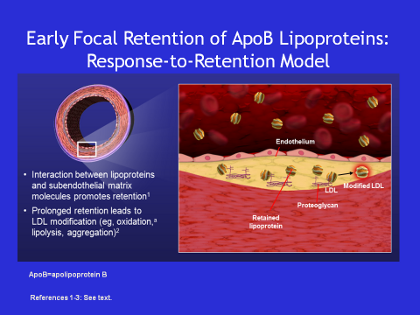McGowan - Figure 11 - Early Focal Retention of ApoB Lipoproteins: Response-to-Retention Model Text
McGowan - Figure 11 - Early Focal Retention of ApoB Lipoproteins: Response-to-Retention Model
The pathophysiology of severe FH is not different from the pathophysiology of other forms of atherosclerosis; it just manifests decades earlier. As shown in the Figure, the early findings in FH are elevated serum ApoB lipoprotein levels. ApoB lipoproteins find their way into the intima where they attach to proteoglycans, which retain them in the intima. The intima subsequently becomes thickened. The longer an ApoB-containing lipoprotein (or LDL) is retained in the intima, the more modified it becomes, the more oxidized it becomes. This leads to recruitment of monocytes from the blood, which diapedese into the intima and become macrophages. The macrophages engulf the ApoB-containing lipoproteins and become foam cells, cytokines are released, and ultimately the result is a very unstable plaque, leading to patients’ being at risk for plaque rupture.
Again, this process is no different in patients with severe FH than in patients who have other forms of atherosclerosis – it just happens decades earlier in severe FH patients.
